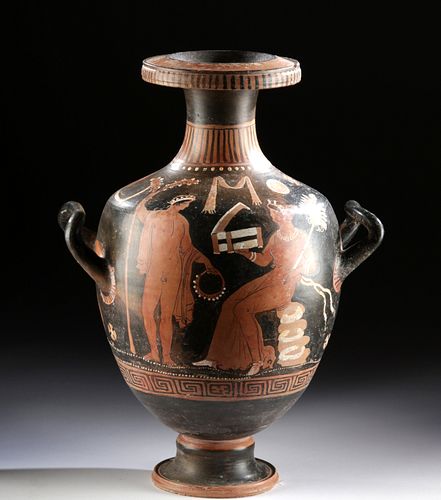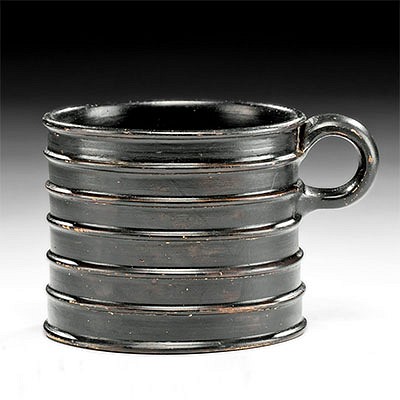Very Fine Greek Apulian Red Figure Hydria
Lot 28c
About Seller
Artemis Gallery
686 S Taylor Ave, Ste 106
Louisville, CO 80027
United States
Selling antiquities, ancient and ethnographic art online since 1993, Artemis Gallery specializes in Classical Antiquities (Egyptian, Greek, Roman, Near Eastern), Asian, Pre-Columbian, African / Tribal / Oceanographic art. Our extensive inventory includes pottery, stone, metal, wood, glass and textil...Read more
Categories
Estimate:
$8,000 - $12,000
Absentee vs Live bid
Two ways to bid:
- Leave a max absentee bid and the platform will bid on your behalf up to your maximum bid during the live auction.
- Bid live during the auction and your bids will be submitted real-time to the auctioneer.
Bid Increments
| Price | Bid Increment |
|---|---|
| $0 | $25 |
| $300 | $50 |
| $1,000 | $100 |
| $2,000 | $250 |
| $5,000 | $500 |
| $10,000 | $1,000 |
| $20,000 | $2,500 |
| $50,000 | $5,000 |
| $100,000 | $10,000 |
| $200,000 | $20,000 |
About Auction
By Artemis Gallery
Mar 12, 2020
Set Reminder
2020-03-12 10:00:00
2020-03-12 10:00:00
America/New_York
Bidsquare
Bidsquare : Ancient / Ethnographic Around The World
https://www.bidsquare.com/auctions/artemis-gallery/ancient-ethnographic-around-the-world-4957
Ancient art from Egypt, Greece, Italy and the Near East, as well as Asian, Fossils, Pre-Columbian, Native American, African / Tribal / Oceanic, Spanish Colonial, Russian Icons, Fine art, much more! Artemis Gallery info@artemisgallery.com
Ancient art from Egypt, Greece, Italy and the Near East, as well as Asian, Fossils, Pre-Columbian, Native American, African / Tribal / Oceanic, Spanish Colonial, Russian Icons, Fine art, much more! Artemis Gallery info@artemisgallery.com
- Lot Description
Magna Graecia, South Italy, Apulian, ca. 4th century BCE. A beautiful and sizeable hydria of a classic form on a raised disc foot with twin handles emerging from the shoulder and one behind on the cylindrical neck as well as a wide flared rim with a convex-edged, slightly downturned rim. The impressive figural/decorative program is all delineated via the red-figure technique with fugitive white and yellow pigments. The body is decorated with an elegant seated draped Maenad holding a large palm frond in one hand and an open casket in the other, with a filet floating above it. She wears a radiate stephane, sakkos, pearl drop earrings, multi-stranded beaded necklace, and ribboned sash over flowing garments that accentuate her feminine form. The Maenad faces a standing Eros, nude save the drapery over his arms and decorative diadem. He holds a tambourine in one hand and a decorative staff in the other. On the reverse is a large, intricate palmette and tendril design. A stupendous example, finely rendered via the red-figure technique with wonderful fugitive paint details. Size: 10.375" W handlespan x 14.875" H (26.4 cm x 37.8 cm)
Contributing further to the painted decorative program are bands of frets on the neck and rim, a lower register of a Greek key variant beneath the figures, and several beaded strands and floating stylized flower motifs (these in added fugitive pigments). A stunning example from the Greek colonists of Apulia.
Provenance: private J.H. collection, Beaverton, Oregon, USA; ex private New Jersey, USA collection, acquired over 20 years ago
All items legal to buy/sell under U.S. Statute covering cultural patrimony Code 2600, CHAPTER 14, and are guaranteed to be as described or your money back.
A Certificate of Authenticity will accompany all winning bids.
We ship worldwide and handle all shipping in-house for your convenience.
#149825A few nicks/losses to rim and foot. There is a repaired probe hole near the central handle and several stable fissures radiating from it. Expected surface wear with minor pigment losses and areas of encrustation.Condition
- Shipping Info
-
All shipping is handled in-house for your convenience. Your invoice from Artemis Gallery will include shipping calculation instructions. If in doubt, please inquire BEFORE bidding for estimated shipping costs for individual items.
-
- Buyer's Premium



 EUR
EUR CAD
CAD AUD
AUD GBP
GBP MXN
MXN HKD
HKD CNY
CNY MYR
MYR SEK
SEK SGD
SGD CHF
CHF THB
THB
















